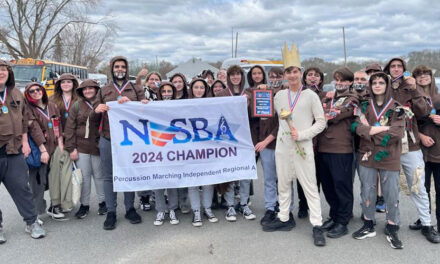Published January 17, 2019
By MAUREEN DOHERTY
NORTH READING — “Never doubt that a small group of thoughtful, committed citizens can change the world; indeed, it is the only thing that ever has.”
This quote, attributed to American anthropologist Margaret Mead aptly describes the mission being pursued by hundreds of townspeople in their opposition to the Ch. 40B application of NY Ventures to build 200 units of rental housing on 19 acres of the former Thomson Country Club at 20 Elm St.
Nick Yebba, owner and operator of Teresa’s Function Facilities, Grille 19, Teresa’s Prime and Resorts North on the property, purchased the site from the Thomson Country Club six years ago. His proposal under NY Ventures would subdivide the site, leaving these facilities intact on the remaining 5.2 acres.
He has proposed to build five 40-unit buildings, each with underground parking plus four living stories above as well as some surface parking. The mix of 1-, 2- and 3-bedroom units plus several 1-bedroom with den units would provide 320 total bedrooms in an area abutting residential single-family homes and the Ipswich River.
The actual golf course and The Greens town home condominiums remain across the street.
The state Ch. 40B statute, on the books since 1969, enables a developer to override local zoning if a community’s total affordable housing stock falls below 10%. North Reading’s was over 10% for several years and recently dropped to 9.6%.
The town was notified on Dec. 7 that Yebba was seeking a letter of eligibility for the site from MassHousing, and the state agency set a site walk for Tuesday, Dec. 18 and then gave the town and any other interested members of the public 30 days to submit their public comments. That deadline was up yesterday, Jan. 16.
Challenge accepted
In a matter of days from that site walk, social media blew up, Facebook pages were created and people who never knew they were neighbors have found common ground in their opposition: the environmentally sensitive Ipswich River — once the third most threatened river in the U.S. in 2003 — and its watershed that serves the drinking water needs of over 300,000 downstream residents, not to mention many who rely on private wells right next door to the site, on Lynn Street, with no opportunity to tie into town water one young mother of three pointed out. This project, they opined, threatens to undo the work done and money invested to bring the Ipswich back from the brink in the past 15 or so years.
One letter writer, Elizabeth Coolidge-Stolz, M.D., of 2 Gillis Drive, obtained 644 signatures, including her own. This was achieved through social media and word of mouth plus a letter-signing and stuffing party run by a dozen volunteers at the library last Thursday night when they collected over 400 signatures. Additional meet-ups and neighborhood canvassing garnered still more signatures. A small group of volunteers explained the process to expect in the coming months if MassHousing accepts NY Venture’s application in which case the town’s Zoning Board of Appeals (ZBA) would be the lead local body overseeing the public hearing process.
Not only did over 600 people sign Coolidge-Stolz’s letter for submittal to MassHousing but another half dozen lawmakers on Beacon Hill who represent towns served by the Ipswich River also received them. She also hand-delivered her letter to an aide to Gov. Baker and several other lawmakers yesterday. It is also printed as a Letters to the Editor in this week’s Transcript. Hundreds of others mailed letters to lawmakers too.
State Rep. Brad Jones greeted 20 of his constituents last Friday at Flint Memorial Library where he listened to their concerns and explained how the process worked. He arrived with a stack of letters and posted a photo on his social media page of another stack arriving Tuesday.
Opponents then filled the meeting room at Town Hall Monday night where Select Board Chairman Mike Prisco allowed many to speak during the public comment portion of the meeting. Town Administrator Michael Gilleberto also reviewed the letter crafted by Town Planner Danielle McKnight to the board members outlining all of the town’s many concerns.
It was also revealed that the town has been requesting an extension of time of 30 to 60 days to enable the town to more thoroughly review Yebba’s plans from an engineering standpoint given all the environmental concerns raised. It was not known at press time if that extension had been given. But the town was fully prepared to submit its concerns by the deadline as well.
A major frustration expressed by the town was the fact that state approved its Housing Production Plan (HPP) in August after over a year in the making with the aid of a $15,000 state grant. It outlines how the town will seek to close the gap of 4/10ths of a percent which amounts to about 20 or so units, but as many pointed out, the ink on that plan was not allowed to dry before the NY Ventures plan arrived even as the town is in the midst of sending out RFPs to pursue senior housing to serve lower income elders.
The property at 20 Elm St was not included in the HPP overlay district for such housing because there are other sections of town better suited to mixed use development that are within walking distance to stores, jobs, schools, the library, etc. whereas the westerly section of town near the Middleton/West Peabody/Lynnfield town lines requires a car to get around. There are no amenities or access to public transportation, stores or jobs even within a reasonable walking distance in any direction, many of the neighbors pointed out, with the exception of the two restaurants owned by the developer.
Jeff Stolz, whose son is disabled and would qualify to live in an affordable unit, pointed out that he could live independently in one of these units as he would not have access to transportation.
A major focal point for many of the residents was the lack of sewerage and the need for an onsite sewage treatment plant per the applicant’s estimates that will treat 35,000 gallons of effluent per day. They felt this was excessive given the proximity of the Ipswich River and the threat they believe a failure would pose to the drinking water of hundreds of thousands. Because the discharge permit is in excess of 10,000 gpd the applicant must get this plant approved by the state DPH.
North Reading also does not have sewerage or access to them; and the majority of town will likely remain on septic even after the town is ready to 100% of its water from Andover rather than the current 60 to 65%. The Andover connection will allow the town to begin the groundwork to tie into the Greater Lawrence Sewer District but only a small portion of the town will be able to get off septic in the decades to come — namely portions of Route 28, Concord Street and Martin’s Pond. The state issues the permits for such discharges and daily flow rates. The town’s goal has been to increase its commercial base by eventually offering sewer in its commercial zones and getting the Martins Pond neighborhood off septic as well.
During the process of reviewing the letter Monday night that the town’s department heads were writing to MassHousing the biggest criticism from the neighbors was that the town was not taking a stance against the project based on its density and environmental concerns. Those in attendance were in agreement that affordable housing is necessary and meeting the 10% threshold remains a worthwhile goal but that there is a better way to do so by following the plan as directed in the state-approved HPP.
The next day Chairman Prisco assured many who had attended the Jan. 14 board meeting that their words had been taken to heart by the staff which had spent five hours on Tuesday completely rewriting it. It was finished just in time for the 4 p.m. Federal Express deadline in order for it to reach Beacon Hill by Jan. 16.




